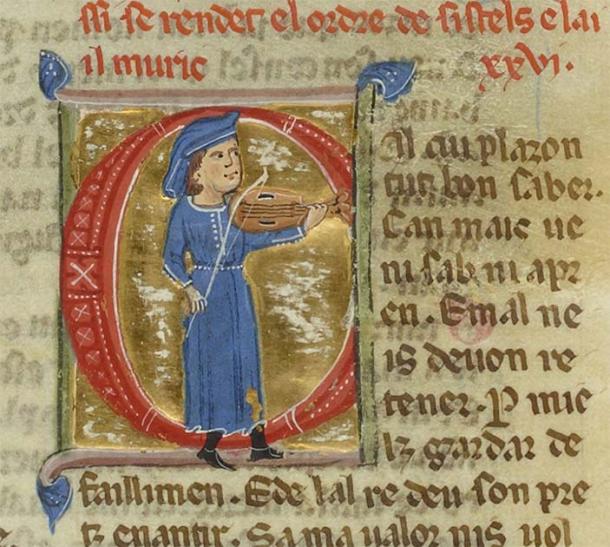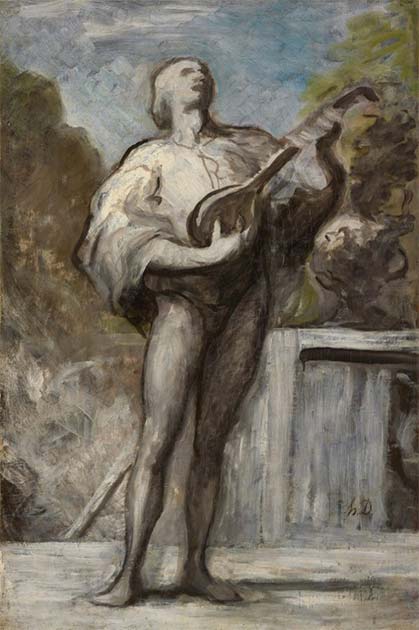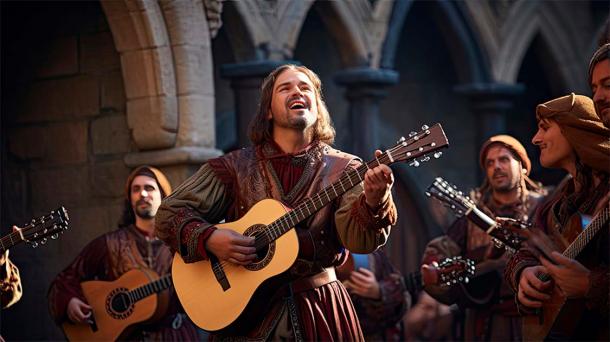
The Chivalrous Melodies and Colorful Lives of the Medieval Troubadours
From the 11th to 14th centuries, medieval Europe was home to a class of poet-musicians known as troubadours. They started out in Occitania in the 11th century before spreading across much of the continent. These artists, not bound by social norms, composed verses and melodies often centered around the ideals of courtly love and chivalry. Armed with lutes and tambourines, troubadours captivated audiences in noble courts and beyond, embodying a unique fusion of poetic expression and musical artistry. Sadly, few of their works survive and many of their songs have been lost to history. These remarkable musicians and writers, hailing from diverse backgrounds crafted a cultural legacy that transcended regional boundaries and can still be felt today.
Early History and Origins of the Troubadours: Songbirds of Medieval Europe
The exact origins of the troubadour tradition are surprisingly complex and no real agreement between academics has ever been reached as to where the tradition came from. These days there are at least eleven prominent theories, each of which one could easily write thousands of words on. That could get a little long winded, so, let’s focus on what we do know.
The earliest troubadour whose work survives to this day is Guilhèm de Peitieus, also known by his more official moniker, Duke William IX of Aquitaine. Born in 1071 AD, William was a remarkable figure, famed for his military and political achievements. Many consider him to be history’s first troubadour, but not everyone is so sure.
- The Curious And Precarious Life Of A Medieval Jester
- Singer-Storytellers: The Griot Tradition in West Africa
Musical historians have pointed out that his work only survived because of his status and its likely earlier troubadours (if they existed) were less lucky. On top of this, his music isn’t 100% original and uses previously established musical structures. Some believe Eble II of Ventadorn, despite being younger than William, was the first true troubadour, but sadly none of his works survive.
Since the 16th century, scholars have speculated that William took inspiration from Arabian and Moorish music and poetry. William served during the Reconquista and the English chronicler Orderic Vitalis referred to William writing lyrics about his time serving in the 1101 Crusade. Later historians have often disagreed, citing the fact that it seems William only fought on the Iberian Peninsula towards the end of his life. In turn, this has been countered with the idea that William likely had people within his extended family of Iberian origins and European friends who spoke Arabic.
In short, if William wasn’t the first troubadour, he was certainly one of the first. While we can’t be sure of the tradition's origins, historians have spent centuries examining William’s works looking for clues. Theories abound as to where the troubadour tradition originated, but it seems most likely it was influenced by a range of sources, Arabic music being just one of them.

Medieval depiction of troubadours at court. (Public domain)
The Spread of the Troubadours
The debate as to whether William IX of Aquitaine was the first troubadour or not is likely to keep raging on. When he died in 1126 troubadours were still rare and records from the first half of the 12th century reveal very few recorded troubadours. This began to change towards the end of the century.
Amazingly, around half of all surviving troubadour works were written between 1180 and 1220 AD. In fact, there are more than 2500 troubadour lyrics that can be traced back to this period.
It’s believed the tradition first gained popularity in western Aquitaine (modern-day southwest France) before spreading to Gascony and then eastern Aquitaine and Provence. During its peak around 1200, it then spread to Languedoc, Rouergue, Toulouse and Quercy.
During the 13th century, just before its decline, it began spreading into Italy and Catalonia and then took over what is now Spain and Portugal. This period of expansion, between 1170 and around 1213, later became known as the rayonnement des troubadours (influence of the troubadours).
So how did the troubadour tradition spread? Through a combination of cultural diffusion, patronage networks and the itinerant nature of some troubadours themselves. Initially rooted in Occitania, the tradition gained momentum as troubadours ventured beyond their regional origins.
While not all troubadours were traveling performers, many were. These traveling troubadours, driven by a desire for patronage and recognition, traveled extensively, bringing their art to different courts and regions. As they wandered through various territories, they carried with them the distinctive Occitan language, poetic forms and musical styles that characterized the troubadour tradition.
Patronage was key to the tradition’s spreading. The hosting of the best, most talented and most famous troubadours became a badge of honor for nobles. As the demand for troubadours grew across medieval Europe, they were tempted away from their original Occitan courts, spreading the tradition as far as northern France, Italy and even the Iberian Peninsula.
Then there was the codification of the poetic forms used by the troubadours. Men like Raimon Vidal, a Catalan troubadour, and Uc Faidit of Query went to great trouble writing down the “rules” of troubadour composition. On top of this, collections of troubadour poetry, known as chansonniers, were compiled and circulated, contributing to the preservation and dissemination of troubadour works. This likely led to the rise of joglars, performers who didn’t write their own poetry but traveled around performing the works of famous troubadours (much to the annoyance of the troubadours themselves).

13th century depiction of a troubadour. (Public domain)
The Classical Period of the Troubadours
While the troubadour tradition kept spreading well into the 13th century, its peak is widely considered to have been between 1170 and 1213. All of the most famous troubadours were active during this period. Later generations, especially 14th and 15th-century scholars, believe it was during this period that the troubadour poetry produced was at its highest quality.
It was also during the classical period that perhaps the most popular genre, canso (love song) came into its own. Of particular note during this time was Bernart de Ventadorn, considered by his contemporaries and later scholars to be the master of canso. Other great names were Giraut de Bornelh, whose biographer described him as history's greatest composer, and Bertran de Born, who specialized in a political song form called sirventes.
As the troubadour tradition spread into Italy, Spain and Portugal during the 13th century it was these classical troubadours whom local poets emulated. Everything from their language and grammar, to style and themes was considered superior to what came after. Emulating their style wasn’t easy, but was made easier by the fact that it was during the classical period that the style's “rules” of composition had been standardized.
Decline of the Troubadour Tradition
By the late medieval period, particularly the 14th century, the troubadour tradition was in decline. Several factors contributed to this decline, marking the end of the troubadour era.
One of the biggest factors that impacted the tradition was the shifting political and social landscape of Europe. Both the Hundred Years' War (1337 to 1453) and the Black Death (mid-14th century) brought widespread disruption and upheaval.
The chaos and uncertainty of these times led to a decline in the patronage system that had sustained troubadours. With noble courts facing economic challenges and social instability, the support for artistic endeavors waned. It seems everyone was a little preoccupied with not dying a gruesome death.
There was also new competition in the form of new literary forms and cultural movements that were rising up to replace the old. The Ars Nova movement, which introduced innovative musical styles, and the emergence of Renaissance humanism shifted literary and artistic tastes away from the troubadour's lyrical and poetic traditions. The music of the troubadours simply fell out of fashion.
Religion also played a role. The Council of Trent (1545 to 1563) and the subsequent Counter-Reformation placed increased emphasis on religious piety and moral rectitude, which led to a diminished interest in the secular and often amorous themes of troubadour poetry.
By the late 15th century, the troubadour tradition had largely faded into obscurity, replaced by evolving artistic and cultural expressions. While troubadour influences persisted in various forms, their distinct tradition had run its course, giving way to new literary and musical movements that characterized the changing times.

The Troubadour by Honoré Daumier, 1868. (Public domain)
Who Could Be a Troubadour?
There are around 450 troubadours known to historians today and they were a pretty diverse bunch. Some were rich aristocrats; some were from the lower classes. Some stuck to one place, living under the patronage of wealthy families, others traveled extensively, spreading the tradition from court to court.
As mentioned earlier, the first known troubadour was William IX, Duke of Aquitaine. He was from the nobility and fought during the Reconquista; for him being a troubadour was more of a hobby. Similarly, the two poets believed to have followed him, Cercamon and Marcabru, are believed to have been nobles, while the third, Jaufre Rudel, was from the princely class.
Many slightly later troubadours are believed to have come from the “poor knight” class. Poor knights were typically young and often from the lower nobility and common backgrounds. These individuals aspired to the ideals of chivalry but lacked the financial means to support the traditional lifestyle associated with knighthood.
In the troubadour tradition, the poor knight often became a literary and cultural figure, embodying the themes of unrequited love and the challenges faced by those striving for noble ideals despite limited resources.
- The Art of Courtly Love: 31 Medieval Rules for Romance
- Hurdy Gurdy Man: Rock Star of the Medieval Music Scene
As time went on the tradition spread to the lower classes. There are examples of troubadours who were middle-class merchants, burgers (an old name for urbanites, not fast food), and even tradesmen who worked with their hands. For example, Perdignon, a popular early 13th-century troubadour, was the son of a poor fisherman, while Elias Cairel, a particularly famous 13th-century troubadour, was the son of a blacksmith.
It was also common for troubadours to have a clerical background. Clerical education included an understanding of musical and poetic forms, as well as vocal training, so a side gig as troubadour made sense for bored holy men. Quite a few vivas (biographical openers written by troubadours) mention the fact that their authors had clerical backgrounds.

Representational image of medieval troubadours performing at court. (javier / Adobe Stock)
Female Troubadours: The West’s First Female Composers
Surprisingly for the time, not all troubadours were men. They had female counterparts called trobairitz. These were the West’s first female composers of secular music, which is pretty exciting.
We have records of around 450 troubadours but there are only twenty to twenty-one (depending on the source) recorded trobairitz. The name itself comes from the thirteenth-century text Romance of Flamenca and is simply the female derivation of troubadour.
As for the number of texts ascribed to trobairitz, that varies quite a bit. There are a handful of anonymous texts believed to have been written by women. In fact, anywhere from 25 to 46 non-anonymous texts believed to have been penned by a lady. Of these, only one survives, the Contessa de Dia.
As for the actual trobairitz themselves, they weren’t quite as varied as the troubadours. It seems many of them had their own styles, but as a group they mainly produced cansos (romances) and tensos (debates). There are also three sirventes (political poems) believed to have been written by trobairitz, one by Gormonda de Monpeslier, and two anonymous. Sadly, the trobairitz don’t seem to have been anywhere near as prolific as the troubadours.
Most of the trobairitz appear to have come from Occitania and around it, although one, Ysabella, is believed to have been born in Italy, Greece or perhaps even Palestine. As far as we know they were all high-born, much like the original troubadours, and seem to have been active in the late 12th to early 13th centuries. The two outliers are Tibors de Sarenom, believed to be the first trobairitz, writing in the 1150s, and Garsenda of Forcalquier, the last of the trobairitz who died in 1242.
The Lasting Influence of the Troubadour Tradition
The troubadour tradition, originating in medieval Occitania's courts, echoes as a lasting influence on European culture. Their verses and melodies traversed boundaries, imprinting a timeless mark. The tradition's decline amidst societal shifts and changing tastes signified a shift in artistic landscapes.
Nevertheless, the troubadour legacy endures, reflecting the timeless resonance of their poetic expressions and musical craft. Beyond a historical chapter, the troubadour tradition remains a poignant reminder of those wandering minstrels who, with lutes in hand, painted tales of love and chivalry across the medieval canvas of Europe. No matter how far back in history one goes, a shared love of music seems to be what binds us to some of our most ancient ancestors.
Top image: Representational image of a medieval troubadour. Source: artemstepanov / Adobe Stock
References
Akhurst. F. 1995. A Handbook of the Troubadours. University of California Press.
Alchin. L. 2018. “Troubadours” in Medieval Life and Times. Available at: https://www.medieval-life-and-times.info/medieval-music/troubadours.htm
The Editors of Encyclopaedia Britannica. 2023. “Troubadour” in Encyclopedia Britannica. Available at: https://www.britannica.com/art/troubadour-lyric-artist
Pound. E. 1913. “Troubadours: Their Sorts and Conditions” in The Quarterly Journal.
Sunders. L. 15 September 2021. “A history of the troubadour: from the High Middle Ages to Bob Dylan” in Happy Mag. Available at: https://happymag.tv/a-history-of-the-troubadour-from-the-high-middle-ages-to-bob-dylan/















